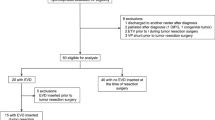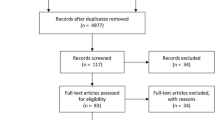Abstract
Background
Patients with posterior fossa lesions causing obstructive hydrocephalus present a unique clinical challenge, as relief of hydrocephalus can improve symptoms, but the perceived risk of upward herniation must also be weighed against the risk of worsening or continued hydrocephalus and its consequences. The aim of our study was to evaluate for clinically relevant upward herniation following external ventricular drainage (EVD) in patients with obstructive hydrocephalus due to posterior fossa lesions.
Methods
We performed a retrospective review of patients undergoing urgent/emergent EVD placement at our institution between 2007 and 2014, evaluating the radiographic and clinical changes following treatment of obstructive hydrocephalus.
Results
Even prior to EVD placement, radiographic upward herniation was present in 22 of 25 (88%) patients. The average Glasgow Coma Scale of patients before and after EVD placement was 10 and 11, respectively. Radiographic worsening of upward herniation occurred in two patients, and upward herniation in general persisted in 21 patients. Clinical worsening occurred in two patients (8%), though in all others the clinical examination remained stable (44%) or improved (48%) following EVD placement. Of the patients who had a worsening clinical exam, other variables likely also contributed to their decline, and cerebrospinal fluid diversion was likely not the main factor that prompted the clinical change.
Conclusions
Radiographic presence of upward herniation was often present prior to EVD placement. Clinically relevant upward herniation was rare, with only two patients worsening after the procedure, in the presence of other clinical confounders that likely contributed as well.

Similar content being viewed by others
References
Cuneo RA, Caronna JJ, Pitts L, Townsend J, Winestock DP. Upward transtentorial herniation: seven cases and a literature review. Arch Neurol. 1979;36:618–23.
Osborn AG, Heaston DK, Wing SD. Diagnosis of ascending transtentorial herniation by cranial computed tomography. AJR Am J Roentgenol. 1978;130:755–60.
El-Gaidi MA, El-Nasr AH, Eissa EM. Infratentorial complications following preresection CSF diversion in children with posterior fossa tumors. J Neurosurg Pediatr. 2015;15:4–11.
Epstein F, Murali R. Pediatric posterior fossa tumors: hazards of the “preoperative” shunt. Neurosurgery. 1978;3:348–50.
Raimondi AJ, Tomita T. Hydrocephalus and infratentorial tumors: incidence, clinical picture, and treatment. J Neurosurg. 1981;55:174–82.
Yadav G, Sisodia R, Khuba S, Mishra L. Anesthetic management of a case of transtentorial upward herniation: an uncommon emergency situation. J Anaesthesiol Clin Pharmacol. 2012;28:413–5.
Vaquero J, Cabezudo JM, de Sola RG, Nombela L. Intratumoral hemorrhage in posterior fossa tumors after ventricular drainage. Report of two cases. J Neurosurg. 1981;54:406–8.
Elgamal EA, Richards PG, Patel UJ. Fatal haemorrhage in medulloblastoma following ventricular drainage: case report and review of the literature. Pediatr Neurosurg. 2006;42:45–8.
Seelig JM, Selhorst JB, Young HF, Lipper M. Ventriculostomy for hydrocephalus in cerebellar hemorrhage. Neurology. 1981;31:1537–40.
Adamson DC, Dimitrov DF, Bronec PR. Upward transtentorial herniation, hydrocephalus, and cerebellar edema in hypertensive encephalopathy. Neurologist. 2005;11:171–5.
McDougall CM, Jack A, Raymond J, Bojanowski MW, Darsaut TE. Angiographic demonstration of upward transtentorial herniation. Can J Neurol Sci. 2014;41:82–3.
Teasdale G, Jennett B. Assessment of coma and impaired consciousness: a practical scale. Lancet. 1974;2:81–4.
Author information
Authors and Affiliations
Corresponding author
Ethics declarations
Conflict of interest
The authors have no conflicts of interest to report.
Rights and permissions
About this article
Cite this article
Braksick, S.A., Himes, B.T., Snyder, K. et al. Ventriculostomy and Risk of Upward Herniation in Patients with Obstructive Hydrocephalus from Posterior Fossa Mass Lesions. Neurocrit Care 28, 338–343 (2018). https://doi.org/10.1007/s12028-017-0487-3
Published:
Issue Date:
DOI: https://doi.org/10.1007/s12028-017-0487-3




